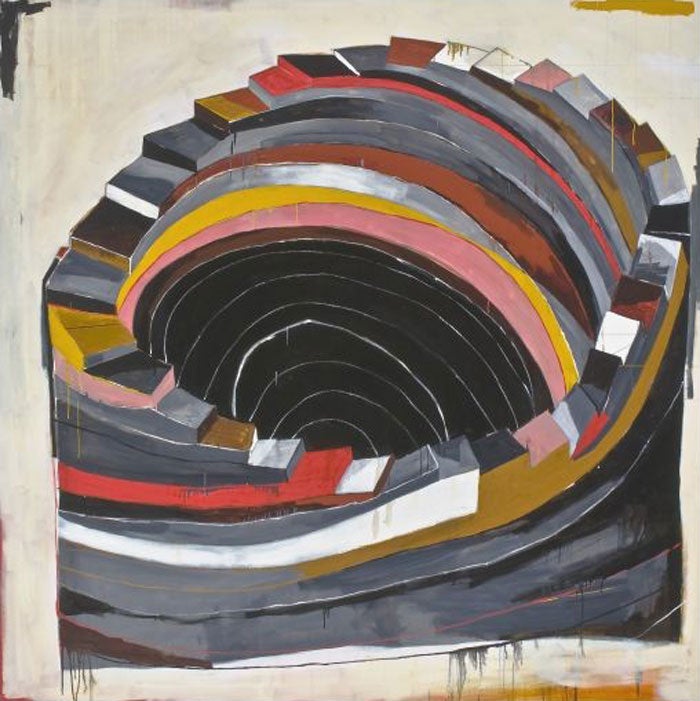Nought to Sixty, ICA, London
It's new, but it's not shocking

Your support helps us to tell the story
From reproductive rights to climate change to Big Tech, The Independent is on the ground when the story is developing. Whether it's investigating the financials of Elon Musk's pro-Trump PAC or producing our latest documentary, 'The A Word', which shines a light on the American women fighting for reproductive rights, we know how important it is to parse out the facts from the messaging.
At such a critical moment in US history, we need reporters on the ground. Your donation allows us to keep sending journalists to speak to both sides of the story.
The Independent is trusted by Americans across the entire political spectrum. And unlike many other quality news outlets, we choose not to lock Americans out of our reporting and analysis with paywalls. We believe quality journalism should be available to everyone, paid for by those who can afford it.
Your support makes all the difference.Established in 1947 by a collective of artists, poets and writers to champion contemporary culture, the ICA has been a haven for the avant-garde, showing experimental work by numerous artists, performers and writers, and engendering debates on a range of contemporary topics.
According to its current director, Ekow Eshun, it is "the home to the best new art and culture from Britain and around the world... the ICA is not so much a place as a principle. A belief in the new. An enduring faith in the creativity of tomorrow."
Brave words. But in 1947 there was an establishment to rebel against, and a cultural orthodoxy that needed to be shaken. Since the late Eighties the art world has become dominated by commercial values. What is new is absorbed into the mainstream quicker than you can say "pickled shark". This leaves the modernist quest, to make things new, in a predicament. The result has been that many of the ICA's recent shows have seemed pretentious rather than radical.
Now, Nought to Sixty is celebrating 60 years of artistic activity. The season of exhibitions and events aims to have a communal and discursive aspect, emphasising the ICA's founding role as a club for artists and a laboratory for experimentation. Most of the artists are under 35 and few have had significant commercial exposure. In some cases this is their first opportunity to mount a solo project in a major public space. In this, the second stage of the programme, there is a documentary video by Seamus Harahan, Alastair MacKinven's Escher-like paintings, a voice-work by Aileen Campbell and lighting interventions by Matthew Darbyshire.
Born in Belfast in 1968, Harahan uses a video camera to take hand-held, seemingly amateur, footage. In Valley of Jehosephat/Version – In Your Mind, images of the Bloody Sunday commemoration in Derry are projected onto two screens. These are accompanied by a late-Seventies roots reggae track by Max Romeo, which refers to a biblical valley of judgement, and by Brian Ferry's 1977 song, "In Your Mind", which suggests some sort of personal philosophical quest. Set against this insistent musical backdrop, Harahan's shaky camera shots of murals and tribal banners, of uniformed bandsmen and drummers marching through the derelict estates of Derry, have a nostalgic and mythic quality. The bleached light suggests something dreamlike and timeless so that this march becomes an archetypal image of all such political protests.
Born in 1971, MacKinven is a performance artist and painter with an obsession about the body. In this series of paintings entitled Et Sick In Infinitum Again, he uses the so-called "Penrose stairs", familiar from MC Escher's 1960s lithograph Ascending and Descending, which appear to connect in an infinite loop. Echoing something of the romanticism of Robert Smithson's Spiral Jetty, MacKinven also destabilises notions of the grid so beloved by modernist painters from Mondrian to Sean Scully. The hospital-style handrails, used by the infirm and the elderly, which surround these paintings, give them a corporeal, sculptural dimension. But MacKinven's odd and edgy paintings are interesting enough without the inclusion of the rather awkward sculpture based on an inverted metal walkway that has been plonked in the middle of the gallery.
Alongside these two artists is the work of Scottish sound artist Campbell, who explores sound-making through the female voice – often employing odd guttural and bodily sounds – while using performance to play with the visual expectations of her audience; and Darbyshire's lighting adaptations in the public spaces around the building that appropriate lighting schemes and colours more associated with commercial companies such as Orange and BP.
Through its exhibition programmes and monthly salon discussions the ICA is aiming to create a wider audience for the contemporary arts, but to do so it may need to drop the tired mantra of the "new". Now may be the time to go for something really radical: the visceral and the authentic.
To 2 November (020-7930 3647)
Join our commenting forum
Join thought-provoking conversations, follow other Independent readers and see their replies
Comments